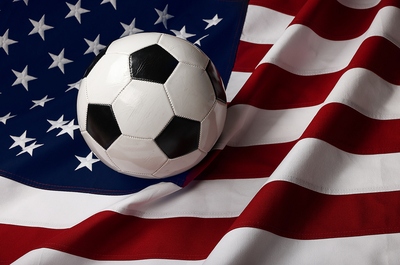 Soccer has long been hugely popular in the US, especially among the younger generations, but over the past 10 years or so it has really exploded. This huge growth in football, as much of the rest of the world calls it, has come about due to a range of reasons. The US held the soccer World Cup in 1994 but this did not really have the desired impact, although it certainly helped sow the seeds for the expansion that would come.
Soccer has long been hugely popular in the US, especially among the younger generations, but over the past 10 years or so it has really exploded. This huge growth in football, as much of the rest of the world calls it, has come about due to a range of reasons. The US held the soccer World Cup in 1994 but this did not really have the desired impact, although it certainly helped sow the seeds for the expansion that would come.
Global soccer stars such as David Beckham, Kaka, Thierry Henry, Andrea Pirlo, and more recently Wayne Rooney and Zlatan Ibrahimovic, appearing in the MLS have certainly helped. But of course, back in the late 1960s, 1970s and early 1980s, the likes of Pele, Gordon Banks, Bobby Moore, Franz Beckenbauer, Johan Cruyff and Eusebio also played in the US, so we cannot put it all down to big-name players.
Forgetting the whys and the hows, the fact is, the MLS is massive at the moment, women’s soccer continues to thrive and this growth is only set to accelerate in the lead-up to, and hopefully after, the 2026 World Cup, held jointly by the US, Canada and Mexico.
If this soccer tsunami has rather passed you by and you don’t understand the difference between 4-4-2 and 3-5-2, haven’t got a clue about the offside rule and thought the World Cup was part of the World Series, fear not! Our simple, beginner’s guide to soccer will have you up to speed in plenty of time for 2026; in fact, in about eight minutes depending on how quickly you read.
Soccer: Basic Rules
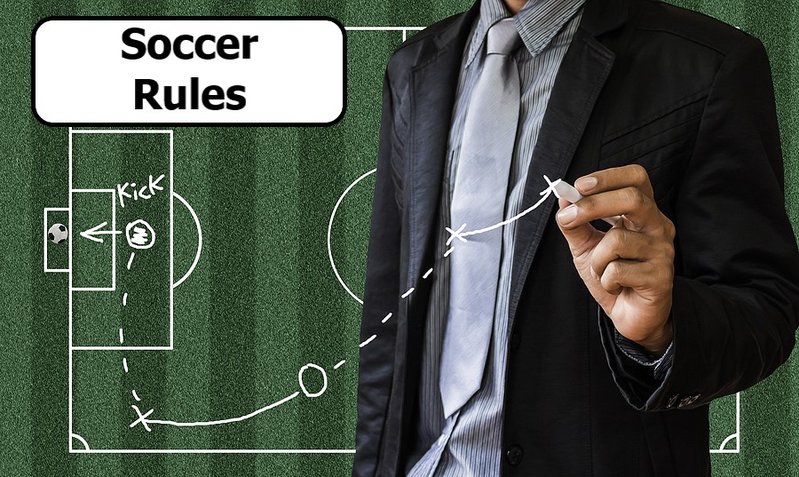
Of the major US sports, soccer is perhaps most similar to ice hockey, since it features two teams aiming to score goals. Each goal, scored by getting the ball into the opponent’s net, has no points value and just adds one to a team’s score. The net, or goal, is 24ft wide and 8ft high.
At the end of the game, whichever team has the most goals wins. If the match is part of a league competition, then if the scores are level, 1-1 being the most common such score, the match ends in a draw. In cups, extra time, like overtime, may be played, with a penalty shootout sometimes used to decide a winner if the scores remain level.
Teams feature 11 players and the only one of those who has a clearly defined role, within the rules of the game, is the goalkeeper. The keeper, as it is often shortened to, is the only player that can use their hands, although only within their own penalty area, otherwise known as the 18-yard box due to its dimensions. The other 10 players have roles within the team but these are flexible and any player can move about the whole pitch freely. Note that the goalkeeper largely operates from within the penalty area and can only use their hands there, but is not confined to this space by the rules.
Games last 90 minutes, split into two 45-minute halves, with a period of between one and six minutes (usually) of additional injury time added on. The clock runs continually from kick-off, with injury, or stoppage time, added depending on events that happen within each half.
Outfield players (everyone except the keeper) can use any part of their body aside from their hands or arms. Should an outfield player use their hands, defined as from the bottom of the armpit and below, a free kick is awarded to the opposition. If the infringement takes place inside their own penalty area, a penalty is awarded.
Players can progress the ball towards their opponent’s goal by running with it at their feet or by passing it to another player. Passes can be made forwards, backwards or sideways and the game continues without interruption until the ball either goes out of play, a goal is scored, or a free kick is awarded.
Ball Out of Play
 The field, which is a rectangle approximately 110 yards by 70 yards, is, for top-level games, made of natural grass (though a small percentage of artificial fibres may be incorporated). Should the ball leave the field of play on the sidelines (the longer sides of the pitch) a throw-in is awarded to the team that did not touch it last before it went out.
The field, which is a rectangle approximately 110 yards by 70 yards, is, for top-level games, made of natural grass (though a small percentage of artificial fibres may be incorporated). Should the ball leave the field of play on the sidelines (the longer sides of the pitch) a throw-in is awarded to the team that did not touch it last before it went out.
If the ball goes out of play either side of the goals, then it is a corner kick to the attacking team if the last touch came off the goalkeeper or any member of the defending side.
A corner gives the attacking team a chance to cross the ball from, well, the corner of the pitch. Statistically, teams score from such opportunities infrequently but even so, a corner is a decent attacking chance.
If the final touch was from the attacking team, then a goal kick is awarded, typically taken by the goalkeeper (though any member of the side can take it).
Free Kicks, Fouls and Penalties
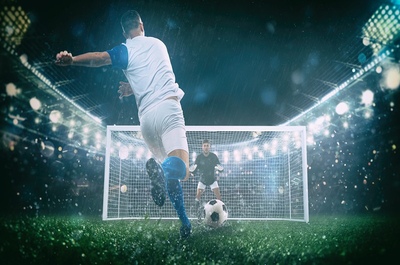 Defending players can only tackle an opponent who has the ball.
Defending players can only tackle an opponent who has the ball.
Blocking, known as obstruction, is not allowed, either to a player with the ball or one without. In order to tackle an opponent a footballer must use any part of their body apart from their hand, but usually their foot, to make contact with the ball first.
If they use their hand, make contact with the player first, pull their opponent’s shirt, use excessive force or endanger their opponent, then a free kick is awarded for a foul. If this offence takes place within the penalty area around the goal their opponents are attacking then a penalty kick is given.
A penalty is taken from the spot, 12 yards out from the centre of the goal. The goalkeeper must stay on their line and with no other players involved the attacker has around an 80% chance of scoring.
Offside
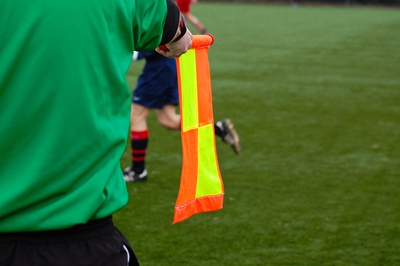 Unlike in rugby and some other sports, where there are various ways in which a player or team can be offside, in football the offside law applies to one specific situation.
Unlike in rugby and some other sports, where there are various ways in which a player or team can be offside, in football the offside law applies to one specific situation.
The offside rule is often portrayed as some complex law that only real soccer fans can understand but in truth it is simple enough.
If the ball is passed forward to a player in the opponent’s half of the pitch, then at least two of the defending team must be closer to the goal at the moment the ball is passed.
If the attacker is level with the defender(s) they are onside, whilst they are also onside if they are not interfering with play (in an instance where they are stood in an offside position but the ball is not played anywhere near them them).
If offside is given, a free kick is awarded to the defending side from the position where the attacker was flagged as offside.
Discipline: Yellow and Red Cards
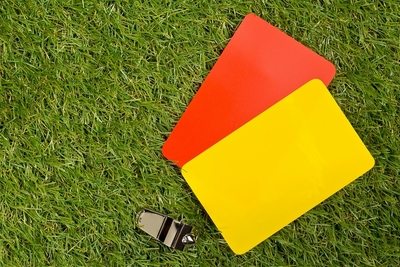 The majority of infringements are punished only with a free kick. However, more serious rule violations, or even just persistent foul play (multiple infringements by the same player) merit a yellow card.
The majority of infringements are punished only with a free kick. However, more serious rule violations, or even just persistent foul play (multiple infringements by the same player) merit a yellow card.
Should a player garner two yellows within the match they will be shown a red card and no longer be able to play in the match.
They cannot be substituted and so their team will play the remainder of the clash with just 10 men.
The most serious infractions will merit a red card automatically, a “straight red”.
Violent conduct, serious foul play, spitting and denying an “obvious goal-scoring opportunity”, either by a deliberate handball or by a foul, are all red-card offences. A straight red may also be shown for using offensive or abusive language.
Substitutions
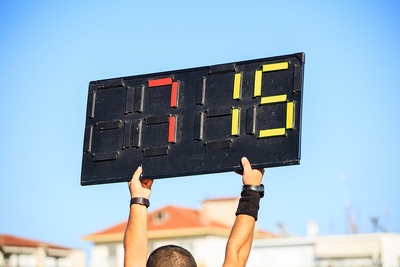 Whilst only 11 players per team are allowed on the pitch at any one time, managers have the option of making a number of substitutions during the game.
Whilst only 11 players per team are allowed on the pitch at any one time, managers have the option of making a number of substitutions during the game.
The number permitted has changed over the years and varies according to the competition. However, as of the 2022/23 season (and onwards), teams in the English Premier League could name nine players on the bench.
Of these nine, a maximum of five can be brought on in any one game, swapping with a player already on the pitch.
These five subs must be made in no more than three windows, plus half time, and the substitution will be indicated by raising a board with both the new and old player’s shirt number.
Teams can substitute off a player who had previously come on as a sub but a player who was previously on the field of play cannot be subbed back on.
Formations and Positions
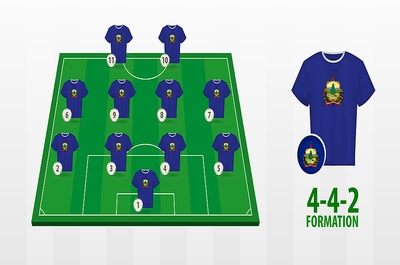 Formations, positions and tactics have evolved a lot over the 150-plus years that football has been played. The only things that haven’t changed are the fact that there are 11 players per team, with one being a designated goalkeeper.
Formations, positions and tactics have evolved a lot over the 150-plus years that football has been played. The only things that haven’t changed are the fact that there are 11 players per team, with one being a designated goalkeeper.
In the modern era it is common for between three and five players to be defenders, with the same number categorised as midfielders, and finally one, two or three attacking players.
When formations are described they do not include the goalkeeper and use numbers to indicate how many players will be in each area of the pitch.
The first numbers are for the defenders, moving left to right from defence to attack. 4-4-2 was a very popular formation in the UK in the 1980s and 1990s, becoming less common in the 21st century, though still reasonably widespread especially in the leagues beneath the Premier League. Such a system used four defenders, four midfielders and two attackers, or strikers.
In recent times a 4-2-3-1 formation has become very widespread, with 4-3-3 a similar but subtlety different option. Both use a left back and right back, and two centre backs in defence. The former then has two central midfielders who play more defensively, with three attacking midfielders spread across the pitch and a single striker in front of them. However, to reiterate what we said earlier, these formations are tactical approaches taken by a team’s manager and are now part of the rules of soccer.
Points
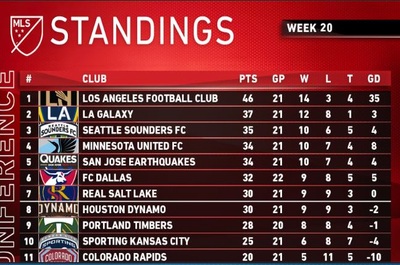 The MLS operates using a slightly different system to many major European leagues but just about all still use the same points system.
The MLS operates using a slightly different system to many major European leagues but just about all still use the same points system.
A team that wins is awarded three points, should sides draw then they get a point each, whilst there are no prizes, or points, for a loss.
In leagues, and cups that have a group stage (effectively a mini-league), should teams be level on points then a tiebreaker is used.
This is often goal difference (the difference between goals scored and conceded by a team over the whole competition).
However, the head-to-head record may be used as the first tiebreaker, with goal difference, goals scored and other metrics used if teams still cannot be separated.
